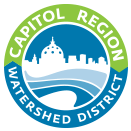Como Lake Fall 2021 Updates
Capitol Region Watershed District (CRWD) has been working to improve water quality in Como Lake for more than 20 years and in 2020, for the first time on record, the lake nearly met the state standard for phosphorous. This means fewer algae blooms, less odor, better habitat and a healthier Como Lake for humans and wildlife alike.
CRWD remains committed to working towards the goals we developed in collaboration with the community and our partners as part of the Como Lake Management Plan. Keep reading to learn more about our efforts to restore the native aquatic plant community, understand the experiences and desires of people fishing at Como Lake, assess the plants in and around the shoreline, and engage residents in prioritizing our work together in 2022-2024.
Restoring Como Lake’s Native Aquatic Plant Community
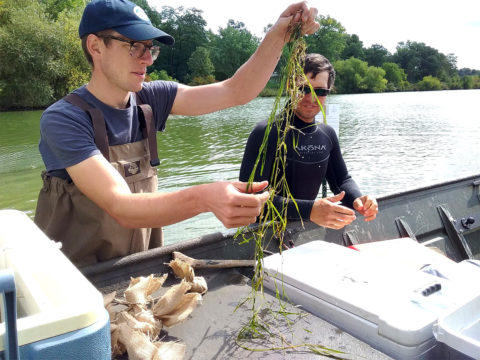
CRWD and the Minnesota Department of Natural Resources (DNR) are working to create a more diverse aquatic plant community in Como Lake by transplanting a variety of native plant species from a nearby lake. On September 14, 2021, over 500 individual plants were transplanted into Como Lake from a list of ten different native aquatic plant species.
Four fenced-in enclosures were constructed around the lake to serve as nurseries for the transplanted aquatic plants. The enclosures protect the them from fish, wind, wave action, and human disturbance so they can take root, grow, and eventually produce more plants. CRWD is closely monitoring the nurseries to see how the plants establish in their new environment.
Aquatic plants are an important part of a lake’s ecosystem because they provide food and shelter for wildlife such as ducks, turtles, fish, and bugs. Como Lake’s native aquatic plant community has declined over the years due to poor water quality conditions and the takeover of an invasive aquatic plant called curly-leaf pondweed. CRWD has been working to reduce curly-leaf pondweed in the lake to allow for native plants to return as part of the ongoing effort to improve Como Lake.
Transplanted species include wild celery, sago pondweed, flat-stem pondweed, , chara/musk grass, coontail/hornwort, elodea/Canadian waterweed, water star grass, large-leaf pondweed, clasping-leaf pondweed, and slender naiad.
Como Lake Fishing Survey
CRWD staff and volunteers gathered over 80 surveys from people fishing at Como Lake from May through October 2021. CRWD trained volunteers to interview people fishing at the lake and collect data. Questions asked included time spent fishing on the lake, target fish species, number and size of fish caught and harvested, and opinions on their interactions with the fish in the lake. The purpose of the surveys is to learn more about public use of the lake, the quality of the fishery and public desires for the future the fishery. The survey also serves as an opportunity to engage and collaborate with the public and offers community science opportunities for volunteers. The quality of the Como Lake fishery and plans to improve it are the focus of the Como Lake Fishery Management Plan (adopted February 2021).
Como Lake Fish Population and Carp Surveys
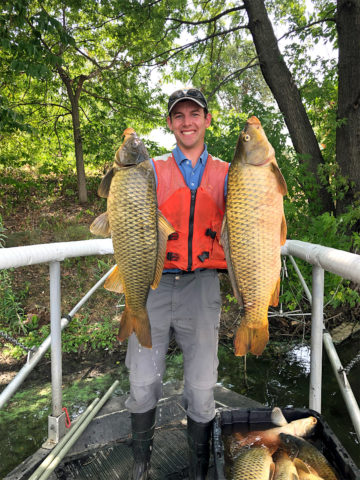
Como Lake fish populations species type and size were surveyed by the Minnesota DNR in June 2021 as part of their routine sampling that occurs every five years on the lake. Data from this survey will be available on DNR’s LakeFinder in winter 2021-2022.
CRWD conducted additional fish surveys in 2021 to capture data that is not included in the routine DNR survey, as recommended in the Como Lake Fishery Management Plan. Additional surveys completed in 2021 include a nearshore fish community survey and physical habitat assessment to evaluate the fish living along the lake’s shoreline and the habitat conditions for nesting areas, fish shelter, and food sources. The nearshore fish community includes smaller species that are not typically captured by the DNR survey but are critical indicators of the food web dynamics that impact water quality in the lake. The data from these surveys will inform future habitat improvement projects.
CRWD also conducted a survey of common carp populations in Como Lake using standardized boat electrofishing techniques. The data is critical for understanding whether a carp removal will be needed at Como Lake. Common carp are non-native species that contribute to poor water quality conditions and prevent native plants from growing.
Plans
Como Lake Shoreline Assessment and Plan
CRWD has been working to develop the Como Lakeshore Management Plan which will guide the maintenance and management of the areas in and around Como Lake’s shoreline over the next 20 years. An assessment of the shoreline was conducted in September 2020 to inform the development of the plan.
The plan will help CRWD and the City of Saint Paul Parks and Recreation staff prioritize routine shoreline maintenance and plan for larger-scale or site-specific shoreline improvement projects.
The Como Lakeshore Management Plan will be developed throughout October-December 2021 and CRWD will seek input on the draft plan in December 2021. Plan adoption is anticipated for January 2022 and implementation will begin in the spring/summer of 2022.
Como Lake Short Term Implementation Plan for 2022-2024
The Como Lake Management Plan (CLMP) is a 20-year adaptive management plan. In fall 2021, CRWD staff with the help of partners and the public will be updating the next Short-term Implementation Plan (2022-2024) of the CLMP.
The Short-Term Implementation Plan defines the specific projects, programs, and actions for the next three years. It includes short-term and ongoing recommended actions from the CLMP and further lists each action’s schedule, estimated cost, lead agency, and partners. Progress achieved from the actions implemented from the current plan is evaluated as part of the new plan development.
CRWD will seek input as the new three-year plan is developed. The public will be invited to provide feedback in late 2021/early 2022. The final 2022-2024 CLMP Short-term Implementation Plan will be adopted in early 2022. Details about the CLMP and a link to the full plan PDF are on the Como Lake page.
View Como Lake pageProtecting Como Lake
Como Golf Course Clean Water Projects
In 2020, CRWD constructed two clean water projects at Como Golf Course to help improve water quality in Como Lake. The projects were recently completed with signs installed nearby. Near the fairway of Hole 7 a large rain garden with an underground infiltration system captures polluted stormwater runoff from 63-acres of land. The water is cleaned as it moves through the soil, removing pollutants that would have otherwise ended up in Como Lake. The stormwater pond between Holes 3 and 11 receives water from 681 acres of land. An iron-enhanced sand filter was added to the pond to remove dissolved phosphorus, a pollutant in the water that fuels algae growth before it flows to Como Lake. A smart control system at the pond outlet optimizes performance of the filter and reduces flooding.
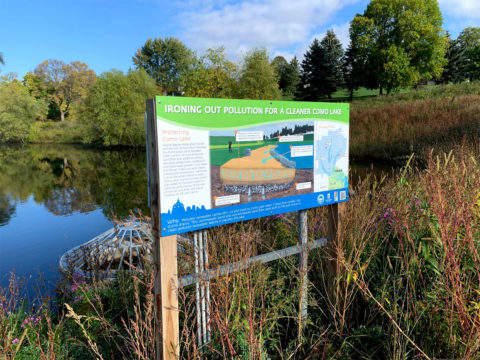
Help Protect Como Lake with Como Curb Clean-Ups
Como residents can help protect Como Lake by joining the Como Curb Cleanups, a neighborhood fall tradition for over a decade. Neighbors commit to clearing the curb in front of their home and alley of leaves during the fall to help protect water quality at Como Lake. The combined efforts of neighbors help prevent pollution and algae in the lake.
Como Curb Clean Ups
Read more about Como Lake
-
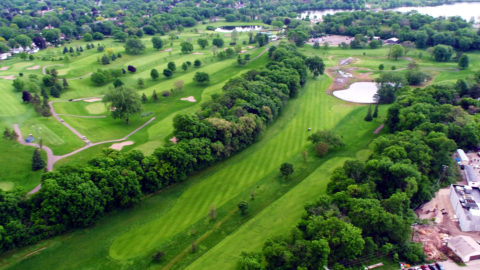
Como Golf Course
Go To Project -
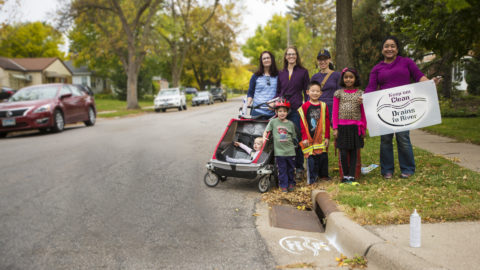
Como Lake Residents Rake Leaves for Clean Water
Go To Project -
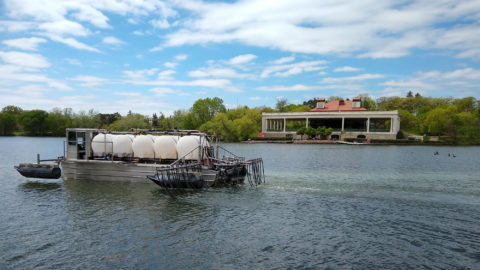
Landmark Improvements in Como Lake’s Water Quality
Go To Project
